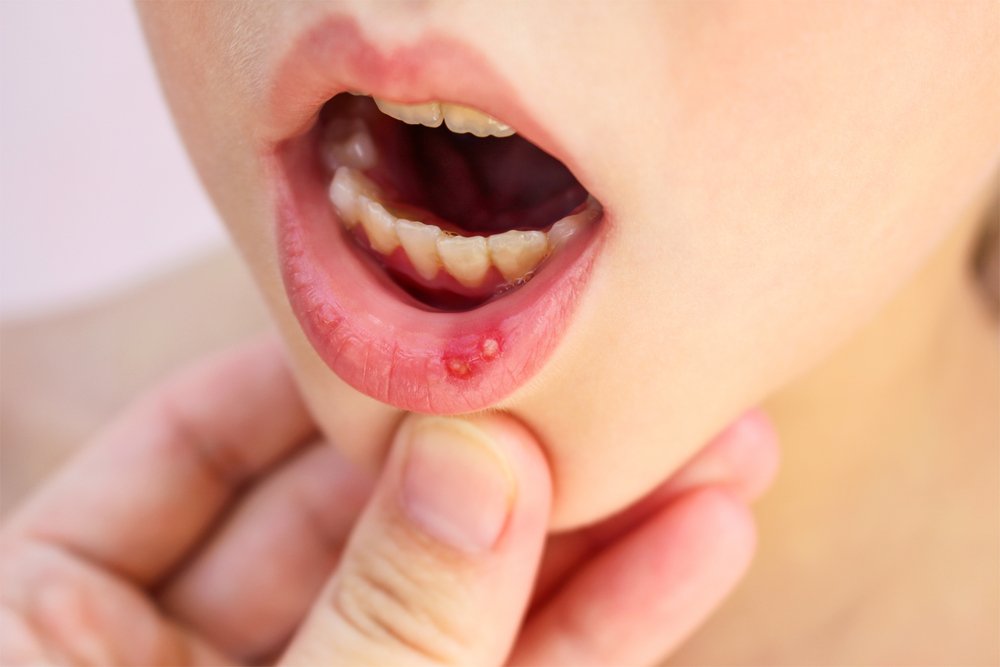Canker Sores

Contents:
Canker Sores in Children
Stomatitis in children is a group of diseases characterized by inflammation of mucous membranes of the oral cavity. Stomatitis is the most common disease in pediatric dentistry, which occurs even in newborn babies.
Signs and Symptoms
How to detect stomatitis in children?
Despite the abundance of reasons that cause this disease, all forms of stomatitis have common clinical symptoms:
- The first symptom of stomatitis is slight redness of mucous membranes located on the gums, palate, tongue and lips.
- Gradually redness cedes place to swelling, arise small round or oval ulcers covered with creamy fur surrounded by a red strip. Such ulcers are very painful; they prevent the child from having a normal lifestyle, eating or sleeping.
- With the development of the inflammatory process, small ulcers merge into one big sore.
- Local symptoms of stomatitis are joined by common symptoms of inflammation: temperature increase, weakness, lack of appetite.
- One peculiar characteristic of stomatitis progression is vomiting. It is due to enhanced functioning of the salivary glands, increased excitability of the baby’s nervous system due to severe pain.
Oral Thrush
In the initial stage, you can notice creamy white cottage cheese-like lesions in the child's mouth. If not treated, they are subject to growth. They are covered with a thin film consisting of strands of mycelium, which is easily removed with a spatula. Under this film, you can find an inflamed mucosa without signs of bleeding. Lesions can be located on the cheeks, gums and inner side of the lips.
Herpetic Stomatitis
It is characterized by high temperature up to 39 °С (102 °F), intoxication, refusal of food. If you carefully examine the oral cavity on the first day of the disease, you will see redness and swelling of the mucous membrane. The next day there will be bubbles filled with clear liquid. In two or three days bubbles burst and you can detect erosion on their place. Photos of stomatitis in children will help to distinguish this version of stomatitis from other diseases. Early diagnosis and proper treatment of herpetic stomatitis contribute to fast recovery.
Aphthous Stomatitis
Symptoms of the aphthous stomatitis are mainly small ulcers on the oral mucosa. At the beginning of the disease when the infection is not detected, it is difficult to establish the true cause of stomatitis occurrence. Ulcers have a round shape and red smooth bottom. They are located mostly on the inside of the cheeks. Symptoms of stomatitis in children may vary depending on the reactivity of immunity. If the aphthous stomatitis is not treated, it is followed by the secondary infection that may complicate the disease pattern. Progression of the disease is characterized by high temperature and pronounced pain syndrome.
Causes Canker Sores

Curiously, each type of stomatitis most often occurs in a certain age group, of course, there are some exceptions, but as a rule:
- Oral thrush commonly occurs in babies from birth to 3 years.
- Herpetic stomatitis – in children from one to three years.
- Allergic or aphthous stomatitis – in school-age children.
Children of any age are subjects to bacterial stomatitis that may be caused by a thermal or mechanical injury of the oral cavity, breach of personal hygiene rules, intake of unwashed fruit as well as eating with dirty hands. It often occurs in toddlers during teething, when “the whole world is in their mouths.” Any stomatitis in children can be explain by the fact that oral mucosa is very delicate and easy to traumatize, while the immune system is not yet able to cope with the mass of infectious agents that enter the mouth of "omnipresent" kids.
Types and Their Treatment
Infectious Stomatitis
It can arise with any infectious disease, caused by bacteria, microbes or fungi. For example, viruses can cause measles or chickenpox. Microbes cause angina, sinusitis, pneumonia, otitis. In such cases, stomatitis can be one of the symptoms of the main disease.
Traumatic Stomatitis
It is caused by the damage of the mucous membranes of the mouth. A child can do it by accident: playing with any object, burning with any hot food or simply eating a candy.
To treat minor injuries it is enough to use manganese solution. To do this, wrap several layers of band on the finger, soak it in the manganese solution and put it to the injury. In more serious cases, the doctor may prescribe healing medications.
Fungal Stomatitis (Thrush)
It is caused by yeast that is present in the oral cavity of a healthy person. In most cases, thrush occurs in weak and premature babies with low immunity. In older children, it may be caused by a prolonged intake of antibiotics.
To avoid vomiting, before each meal rinse the baby’s mouth with soda solution (1 dessertspoon for a glass of boiled water). In between feedings, lubricate the oral cavity with 10-15 % solution of borax glycerin.
Allergic Stomatitis
It accompanies any allergic reaction to a food product. Thus, mucous reacts to a product that is not accepted by the body. To prevent this in the future, it is desirable to start a diary where you can put down your baby’s reaction to different products.
To treat this condition, first, you need find out which product has caused allergic reaction and exclude it from the baby’s diet. Then rinse the baby’s mouth with furacilin, saline solution, or solution of calendula.
Herpetic Stomatitis
The child may get infected with the herpes virus from adults through dirty hands and toys or airborne droplets. This disease mainly affects children between one and three years. At this age, protective antibodies received from the mother start to disappear, while his own immune system is yet under formation.
During treatment, make your baby rinse mouth with camomile, calendula, and oak bark infusions as often as possible. Use warm boiled water for rinsing. You should also put 0.25% oxolinic ointment on the lips of your kid.
Prevention

The Best Way to Prevent Stomatitis in Children, and it is Possible the Child to Get Protected from this Scourge?
- Keeping child's mouth clean is the main protective factor against Stomatitis (to recognize it, please refer to the article: symptoms of stomatitis in children). Therefore, the main task of parents is to ensure hygiene of the mouth of your baby.
- If the breastfed baby is inferior to one year, mom has to monitor the purity of her own breast, and purity of the feeding tools. In addition, you need to daily wipe baby's mouth with a special sponge or brush.
- Make sure to clean your baby’s teeth twice a day: if they are small (under 5 years), parents should do it themselves; Children from 6 to 10 years should do it under the strict supervision of their parents.
- Teach your children to frequently wash their hands: after coming back home or visiting toilets as well as before each meal.
- You should teach your children to rinse the mouth after eating.
- Make sure to keep away from your child's mouth foreign, often dirty items teeming with bacteria and infections.
- Wean your child off thumb sucking.
- If followed properly these recommendations will help reduce the risk of your baby getting stomatitis almost by 80 %.
- Any oral diseases may cause stomatitis. Therefore, first signs of tooth decay or any other suspicious symptom must be the reason to promptly see your doctor.
- Do not self-medicate in any case. Professional dentist assistance and timely treatment of milk teeth in children is the basic preventive measure against child stomatitis.
- Provide your child a balanced diet, containing all the vitamins and minerals necessary for growth and development. The lack of those is one of the reasons deteriorating the mouth microflora, resulting in ulcers and exhaustion of the oral mucosa. If necessary, consult a doctor to give your child vitamin complexes.
- Keep your child away from spicy, hot and too sour food: for all this can easily injure the mucosa and cause mouth ulcers.
Unfortunately, most parents do not even think that the stomatitis, they are safeguarding their child from, is rooted in his environment.
Total body resistance to infection decreases, when:
- the child is a "passive smoker” which swallows clubs of nicotine smoke easily eroding his mouth mucosa;
- the child breathes in wine vapors, when someone in the family is drinking;
- if in his group in the kindergarten there is a child suffering from stomatitis, or other members of the family has already contracted the disease.
To prevent stomatitis your child needs to breathe fresh air, have regular walks and learn rules of behavior with other children if he is already in the age of reason (5-6 years old). You need to isolate the child from those people who currently suffer from stomatitis: remember, it is a contagious disease! Parents of kids of any age should take steps to prevent stomatitis. It is much easier to prevent this disease than to treat it.
Video: How to Treat Canker Sores